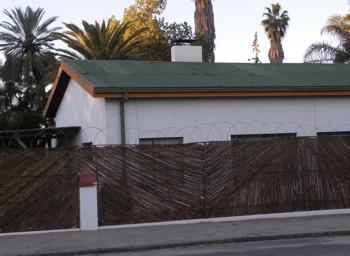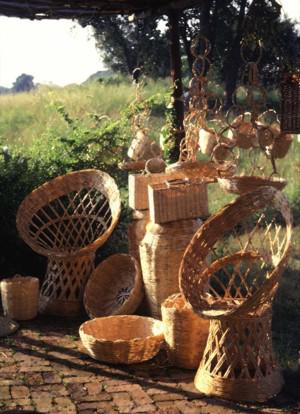Phragmites australis
Phragmites australis (Cav.) Steud.
Family: Poaceae
Common names: commom reed; fluitjiesriet (Afr.); lehlaka (SeSotho.); umHlanga (isiZulu.); lutanga (Tshivenda.)
Introduction
Phragmites australia is a cosmopolitan perennial grass/reed with grey-green leaves and a light brown to purple inflorescence and the flowers are surrounded by silky white hairs.

Description
Description
Phragmites australis is a robust, perennial reed up to 4 m high, with long rhizomes. Culm is solitary, not tillering.
The leaf blade with a filiform apex, flexuous, 350 x 35 mm. Leaf sheaths remain on the culm after the leaves have fallen off. Inflorescence is compact, 120–400 mm long, with a ring of silky hairs at the base of lowest branches. The spikelet is 10–18 mm long; upper glume (the bracts at the base of the spikelet) 6–9 mm long and is acute; lemma (encloses grass flower) glabrous; callus hairs 6–10 mm long; anther 1.5–2.0 mm long. Flowering time: December to June.

According to the Wikipedia, Phragmites australis, can form stands as much as much as 1 square kilometre or more in extent where conditions are favourable. It can also spread at 5 metres or more per year by horizontal runners. As well as growing in damp ground, it can grow in standing water up to 1 metre or so deep, or even as a floating mat. It also tolerates brackish water and can grow near the sea in estuaries or salt marshes. It can be very invasive, but can be suppressed by grazing with livestock or repeated burning. (http://en.wikipedia.org/wiki/Phragmites: consulted 12/01/2015)

Conservation Status
Status
The SANBI Threatened Plants Programme has as yet not indicated its conservation status. Phragmites australis frequency in southern Africa is common or locally dominant.
Distribution and habitat
Distribution description
Phragmites australis occurs throughout the world. The distribution is cosmopolitan. In South Africa it is widespread in aquatic and semi-aquatic areas. It is common especially in riverbeds and wet places in all vegetation types. It grows in all soil types, as long as there is adequate moisture. It can form dense stands particularly as a dominate species.
Derivation of name and historical aspects
History
Phragmites is derived from Greek word Phragma for a ‘hedge’ which means species whose stems are used for making hedges or fences (boundary). The genus Phragmites has ± 3 species; 2 species are found in southern Africa and they are widespread in aquatic or semi-aquatic habitats.

Uses
Use
Phragmites australis is of little value for grazing however, it plays a very important ecological role in wetlands by protecting the soil from flooding, filters the water and sometime becomes established in gullies to control soil erosion. It offers shelter to many bird species and other animals. Human uses for common reed include the use for light construction work, as a thatching grass, and for making mats, baskets, medicinally and arrows. It is even used to make paper and is used in the chemical industry.

Growing Phragmites australis
Grow
Phragmites australis is not usually cultivated in gardens. It should be easy to grow in damp soil or wetlands and will grow fast if conditions suit it. Its growth should be carefully monitored to avoid it becoming invasive.
References
- Gibbs Russell, G.E., Watson, L., Koekemoer, M., Smook, L., Barker, N.P., Anderson, H.M. & Dallwitz, M.J. 1990. Grasses of southern Africa. Memoirs of the Botanical Survey of South Africa No. 58.
- Leistner, O.A. (ed.). 2000. Seed plants of southern Africa: families and genera. Strelitzia 10. National Botanical Institute, Pretoria.
- • Van Oudtshoorn, F. 1999. Guide to the grasses of southern Africa. Briza Publications, Pretoria.
Credits
Mashau Aluoneswi Caroline and Muthanyi Mphatheleni Ephraim
With additions by Yvonne Reynolds
National Herbarium (Pretoria)
January 2015
Plant Attributes:
Plant Type: Grass
SA Distribution: Eastern Cape, Free State, Gauteng, KwaZulu-Natal, Limpopo, Mpumalanga, North West, Northern Cape, Western Cape
Soil type: Sandy, Clay, Loam, Brack/saline
Flowering season: Sporadic/All year
PH:
Flower colour: Brown, Purple
Aspect: Full Sun, Shade, Morning Sun (Semi Shade), Afternoon Sun (Semi Shade)
Gardening skill: Easy
Special Features:
Horticultural zones











Rate this article
Article well written and informative
Rate this plant
Is this an interesting plant?
Login to add your Comment
Back to topNot registered yet? Click here to register.